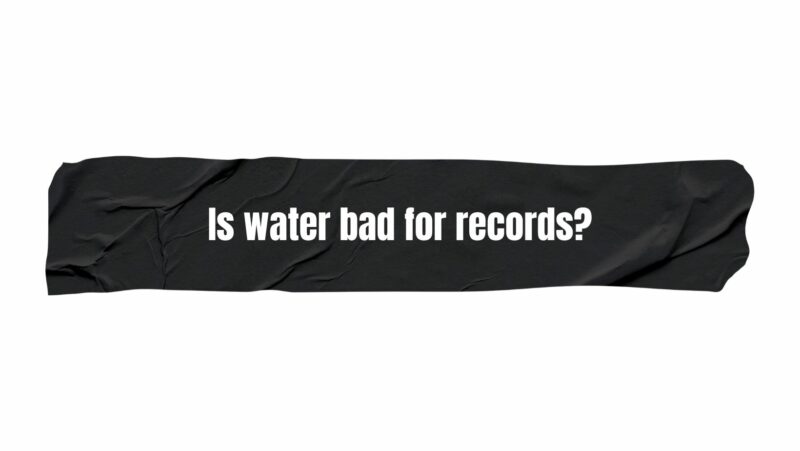In the realm of music appreciation, vinyl records remain an enduring symbol of authenticity and artistry. The ritual of placing a vinyl record on a turntable, hearing the soft crackle as the needle makes contact, and immersing oneself in the melodious waves of sound is an experience cherished by audiophiles and collectors. However, with the reverence for vinyl comes a pressing question: Is water bad for records? This article embarks on a comprehensive exploration of the relationship between water and vinyl records, examining the potential risks, scientific explanations, and best practices for preserving these iconic musical treasures.
The Intricacies of Vinyl Records: Before delving into the impact of water on vinyl records, it’s crucial to understand the intricate nature of these musical artifacts. Vinyl records are composed of polyvinyl chloride (PVC), a flexible material that can be affected by temperature changes, humidity, and exposure to liquids. The grooves etched into the record’s surface are meticulously crafted to carry the audio information, and any disturbance in these grooves can profoundly affect the playback quality.
The Dangers of Water Exposure: Water, an elemental force essential to life, poses a threat to the delicate structure of vinyl records. Direct contact with water can result in a range of detrimental consequences, including warping, mold growth, and degradation of the vinyl material. Warping, a common issue, occurs when the record absorbs moisture unevenly, causing it to lose its flat shape. Additionally, the damp environment created by water exposure provides a breeding ground for mold, which can cause discoloration, odors, and even structural damage.
Water and the Fragile Grooves: The grooves on a vinyl record are the conduits through which music flows, holding the intricate details of sound. When water comes into contact with these grooves, it disrupts their precise geometry and alignment, resulting in surface noise, skipping, and compromised audio quality. The physical properties of water, such as its ability to seep into small spaces, exacerbate the potential damage it can inflict on records.
Cleaning vs. Water Exposure: The desire to maintain vinyl records’ optimal condition often leads to inquiries about using water for cleaning. While water seems like a logical cleaning agent, it falls short in terms of maintaining the records’ structural integrity. Cleaning vinyl records involves a delicate balance between eliminating debris and preserving the grooves, and water alone does not offer the necessary balance for effective cleaning.
Effective Cleaning Techniques:
- Dry Brushing: Utilizing a specialized carbon-fiber brush, enthusiasts can gently remove loose dust and particles from the record’s surface. This method serves as an excellent starting point for routine maintenance.
- Record Cleaning Solutions: Developed explicitly for vinyl records, cleaning solutions dissolve dirt without damaging the material. These solutions are typically applied with a soft, lint-free cloth or a designated cleaning pad, following the natural direction of the grooves.
- Record Cleaning Machines: For those who seek a meticulous approach, record cleaning machines offer a safe and thorough method. These machines employ a combination of cleaning solutions and vacuum suction to extract dirt without causing harm to the grooves.
Distilled Water in Record Care: While water’s direct impact on vinyl is a concern, distilled water plays a role when used judiciously. Distilled water lacks impurities and minerals, making it a safer option for vinyl maintenance. It can be combined with record cleaning solutions to dilute their strength and facilitate a gentler cleaning process. However, precise application and avoidance of excessive moisture are imperative to prevent damage.
Preserving Against Water Exposure: Prevention emerges as the ultimate safeguard for preserving vinyl records. Storing records in a cool, dry environment away from direct sunlight, humidity, and potential sources of liquid is paramount. Should water inadvertently make contact with a record, prompt action is crucial. Blotting the affected area with an absorbent, lint-free cloth and allowing the record to air-dry aids in minimizing potential harm.
Conclusion: The exploration of whether water is bad for vinyl records delves beyond mere curiosity. Vinyl records are cultural artifacts that embody history, sentiment, and artistry. Water’s impact on these treasures lies in its potential to disrupt the intricate grooves that breathe life into music. While water can indeed harm vinyl records, an informed approach to cleaning, cautious use of distilled water, and preventative measures can help maintain the delicate balance between preserving records’ structural integrity and relishing their timeless melodies. As audiophiles continue to bask in the analog glory of vinyl, the appreciation of these musical treasures demands a careful dance with water’s potential consequences.


